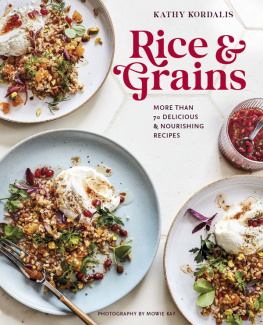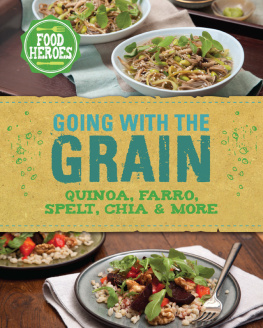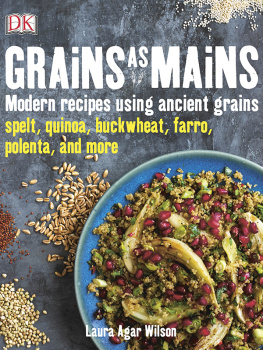The New Whole Grains Cookbook
The New Whole Grains Cookbook
Terrific Recipes Using Farro, Quinoa, Brown Rice, Barley,
andMany Other DeliciousandNutritious Grains
by Robin Asbell
PhotographsbyCaren Alpert


Text copyright 2007 byROBIN ASBEL.
Photographs copyright 2007 byCAREN ALPERT.
All rights reserved. No part of this book may
be reproduced in any form without written
permission from the publisher.
eISBN: 978-1-4521-0042-5
Designed byJAY PETER SALVAS
Prop styling byCAROL HACKER
Food styling byBASIL FRIEDMAN
Raw rice plants courtesy of MASSA ORGANICS, Chico, California.
Chronicle Books LLC
680 Second Street
San Francisco, CA 94107
http://www.chroniclebooks.com
ACKNOWLEDGEMENTS
To Stan, the love of my life and my biggest fan, thanks for eating the same thing over and over until I got it right.
This book came into being because of Antonia Allegra and Nion McEvoy, and I thank both of them for believing in me. Working on the book with Amy Treadwell has been a wonderful experience.
My friends and family made the writing life possible, and their support keeps me going. Special thanks go to my client family, the people who tasted and praised these recipes more than anyone else. Your palates are a part of me, after all these years.

Everything old is new again. Ancient foods, once discarded on the road to progress, have come back into vogue. It turns out that the very old-fashioned habit of filling up on unrefined grains still suits the human body perfectly. Many of the grains I will be discussing in this book have been cultivated for thousands of years, and were the central nourishment for the cultures that flourished around the fields.
And yet many of you have never even heard of them. Rediscovering these delicious, beautiful foods is going to be fun.
In the last hundred years, our taste for refined foods has gotten the better of us. In stripping off the nutritious outer layers of the few grains we continue to consume, we throw out the minerals, antioxidants, and fiber, keeping only the quick-burning starches and a bit of protein. White bread and white rice are the only grains most Americans eat.
The evidence that we need to get back to the whole grain grows every day. In 2005, the U.S. Department of Agriculture changed its food pyramid and began urging Americans to eat at least three servings a day of whole grains, up from the paltry single serving it recommended previously. This change was in response to studies clearly indicating that consumption of whole grains lowers the risks of heart disease, cancer, diabetes, stroke, obesity, and other killers. We often hear about the fiber in grains, but that is only one of the important elements in the equation. Antioxidants, which work in the body to prevent cell damage, are also found in plant foods. Researchers at Cornell University found that whole grains are actually higher in antioxidants than fruits and vegetables are. Whole grains also contain the minerals that are deficient in the typical American diet. See Whole-Grain Synergy for more science.
So why dont people eat enough whole grains? It all started during the Industrial Revolution. Whole grains, with their traces of good fats, spoil more easily than refined ones. The bran layer on the outside of each grain and the germ at the tip, are where the essential fatty acids and enzymes are usually stored, along with the minerals and antioxidants. Milling the bran and germ away makes a starchy product that wont spoil. Once large-scale milling made white flour affordable, people could keep a bag of it on a shelf for years. White foods carried a cachet of refinement, even as they became cheap.
In the last few years, however, attitudes have changed. Now a grain like Purple Prairie barley or Jobs tears commands a premium price and appears in tiny portions in the best restaurants. Chefs have discovered the subtle balance that can be created on the plate with these unique, flavorful foods. Unlike neutral starches, whole grains can even play a part in wine pairing, with earthy and sweet notes to complement the wine.
When it comes to whole grains, freshness matters. People who are used to shelf-stable white flours often forget that whole wheat and grains can actually spoil. Whole grains contain varying amounts of fat and enzymes that will go to work breaking down the grain at room temperature. Once the grains are ground to make flour, they are even more delicate, so unless you will be using them up within a month, keep them in the refrigerator or freezer.
On the physical level, sugar and white flour give us a rush. Contemporary science has brought us the glycemic index, a tool dietitians devised to help diabetics choose foods that would have the least impact on their blood sugar. The index rates foods on how much and how fast blood sugar rises when the food is eaten on an empty stomach. The high glycemic index rating of white flour and white rice means that they cause a spike in blood sugar, and then a rapid drop. Higher-fiber whole grains release carbohydrates more slowly into the gut. To simplify, stick to whole grains for slow-burning carbs.
If you are new to whole grains, you might want to make a gradual transition away from the soft, bland white ones. White flour is like a blank canvas, on which delicate washes of flavor, like butter and eggs, dominate. Without its hearty bran and germ, white flour is light and higher in gluten and is easy to leaven into airy constructs. Even so, balancing hearty flavors, adding a bit of gluten flour to breads, and just learning to love the sweet, nutty flavor of wheat are all easy to do. Wimpy white bread seems insubstantial once you are used to the real thing.
in the Equipment chapter, start serving whole grains as a bed for your favorite stir-fries, curries, and saucy main dishes. Take care at first to make sure you cook them until they are fully tender, so your system will not be taxed by hard, undercooked grain. Once youve made this change, look to the recipes for creative ways to use whole grains in all sorts of dishes. Most of the recipes can be modified for vegetarians by using vegetable stocks and substituting tofu, tempeh, or mock meats.
The baking recipes in this book use only whole-grain flours. If you are new to this type of baking, you can easily substitute unbleached wheat flour for half of the whole wheat flour. The results will be lighter than the whole-grain version, but better for you than processed foods. As you fall in love with the flavor and heft of whole grains, gradually work up to all whole flours. The important thing is to get more whole grains and enjoy your food at the same time.
WHOLE-GRAIN SYNERGY
According to Leonard Marquart, PhD, RD, and professor at the University of Minnesota Department of Science and Nutrition, cancer rates would drop by up to 40 percent if whole grains replaced refined products. A very positive chain of events starts when these grains enter the digestive system. The fiber in grains contains proteins; starches; vitamins E and B complex, including folate; and minerals. Selenium and protective antioxidant chemicals are also carried by the fiber. As those are being absorbed, the carbohydrates, insulin, and fiber start to ferment, feeding the good bacteria in the gut. This activity lowers the pH of the colon and produces a compound called butyrate, both of which are associated with lowered cancer risk.
Next page










